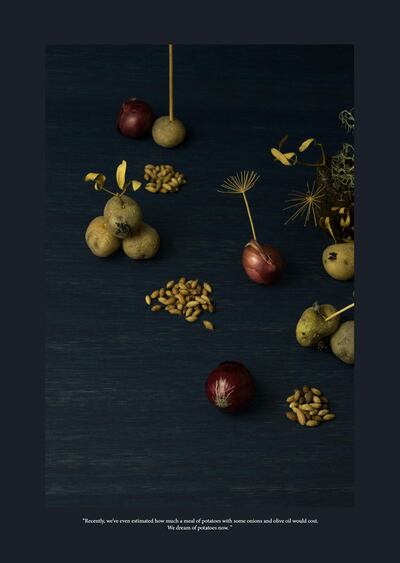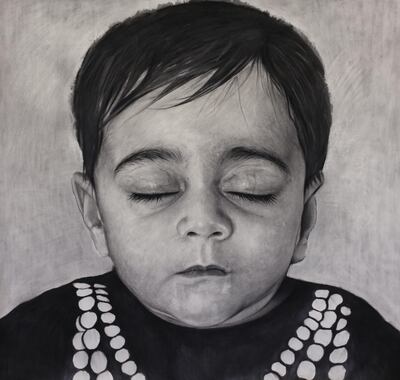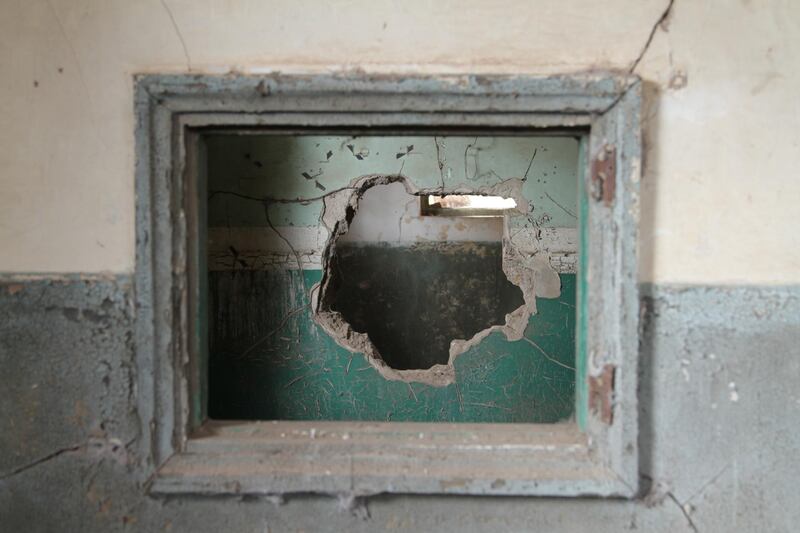“Before the siege, my mother suffered from diabetes. Now she feels much better,” reads a line of text below a photograph showing three meagre piles of crumbs beside an empty serving dish.
The juxtaposition of text and image is part of a series by Polish-Syrian artist Anna Banout based on recordings of testimonies from Syrian refugees living in Lebanon. In (Still) Life, she conveys the intimacy and individuality of women's experiences through five photographs, each a contemporary take on classical still-life compositions. "I find women amazing in general, but also in the face of this conflict. They are extremely strong," Banout says. "Unimaginable tragedies have happened to them and they can still joke. What touched me in those interviews was the little details that really captured the intimacy of their dreams and their hopes."

One woman recalls how her husband used to bring her fruit at night, before he was arrested. Her words are accompanied by a photograph of fresh melon and citrus fruits and a lacy brassiere hanging from a vase of dried flowers.
Another work obliquely references rape, with the quote: "After she was released from prison, people in our town started talking. They said she was rotten." The accompanying photograph is a beautiful composition capturing dead leaves and a lemon covered with green mould, a tribute to traditional vanitas paintings featuring dead flowers or skulls to convey the transience of life. Banout's moving work is on show at Station Beirut as part of a collective exhibition entitled In Need of Archives: Memory Revisited. Organised by Berlin-based Syrian artist and curator Khaled Barakeh, in collaboration with local NGO Dawlaty and Syrian Cultural Index, the exhibition features new works by four Syrian artists, alongside archival pieces by seven international artists. The four Syrian artists were each given funding to create a work based on the Syrian Oral History Archive, a collection of refugee testimonies recorded in Lebanon.
“I want to promote the idea of using archives among Syrian artists,” says Barakeh, who was forced to curate the show from a distance, through a series of emails, photographs and Skype calls, after his visa application was rejected. “I don’t think we can really move forward without looking back at history, and I believe that archives are one of the most important tools in times of conflict because they can serve as bridges,” he says.
The pieces on show by international artists illustrate a wide variety of approaches to using archival material. People in Trouble Laughing Pushed to the Ground, is a series of black-and-white photographs by Adam Broomberg and Oliver Chanarin, revealing the sections of photographs of the Irish civil war hidden beneath circular stickers affixed to the contact sheets. Other works on show use video clips from Orientalist films, tweets sent during the Egyptian revolution and fragments of documents from Lebanon, displayed on clipboards for visitors to flip through, uncovering everything from vocabulary lists, to cartoons, to political speeches.
A particularly harrowing work by Kurdish-Iraqi artist Behjat Omer Abdulla dominates one of the two gallery spaces. His enormous, photorealistic black-and-white drawings of sleeping babies were inspired by a horrific story of a mother crossing the Mediterranean with her twin sons. When one baby died, the smugglers waited until she was asleep and then threw her child’s body overboard. When she awoke, she found that they had mistakenly thrown the living twin into the sea.

Alongside Banout, the commissioned Syrian artists are Fadi Aljabour, Randa Maddah and Mohammed Omran. Each has taken a different approach to working with the archived testimonies.
Aljabour's work is an eerily lifelike sculpture of an old woman, sitting on a plastic chair. The artist, who has been living in Berlin for the past eight years, found he was unable to stop thinking of a testimony about a woman who was killed in the Ghouta chemical attack. As the war progressed, she stopped hoping that she wouldn't die, and began to hope that she would die with dignity, with her clothes on and her body in one piece. The chemical attack fulfilled this bleak wish. "It's strange when you live war through the internet. Every night the war is in your dreams and then you go out into a different life," says Aljabour, who has watched the conflict unfolding from a distance in Germany. "I wanted to focus on that weird logic, where dying in one piece became a happy ending."
Maddah's work, Restoration, is the most abstract. The 12-minute video reflects on how memories change over time. It begins with still footage of a hole blasted through a wall. As the video unfolds, a woman methodically covers the hole with strips of tape and then paints over it until it is no longer visible, concealing the wound beneath a thin layer of camouflage.
Omran's work, Black Box, is an installation featuring a zig-zig strip of paper spilling out of a small box. The artist chose to illustrate elements from many different testimonies. A woman carrying a suitcase stands before a heap of rubble. Two men hold the severed head of a third, covering his mouth as though afraid that in death he might speak. A woman gives birth beside a blind man with a raven on his head.
These glimpses of stories that convey the “epic Syrian apocalypse,” as he describes it, are contained within a box that symbolises protection – a repository for precious belongings – and the black box on a plane that records the details of a flight so that in the event of a plane crash events can be pieced together by investigators.
In Need of Archives is a powerful show, featuring nuanced, complex works that are rooted in the Syrian war but resonate on a wider level, demonstrating the impact of individual stories.
"When you think of archives, you think of the past, something that belongs to history," Banout says. "Those people do not belong to history. They are present, they are still there. They still have futures ... that's why my piece is called (Still) Life, because not only are the photographs still lives, but I really wanted to highlight that even in times of war there are still dreams and hopes and intimacy and humour – there is still life. There is still something to hope for."
In Need of Archives: Memory Revisited continues at Station Beirut until July 8
____________________
Read more:
[ Street artist Banksy splashes Paris with works on migrants ]
[ Christo on his Abu Dhabi desert dream: 'I hope to do the project before I die' ]
[ In the frame: The story behind Ai Weiwei's Fountain of Light at Louvre Abu Dhabi ]
____________________





